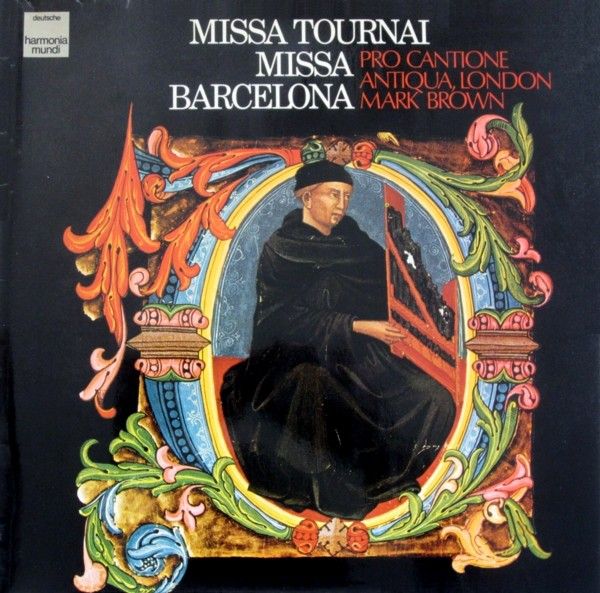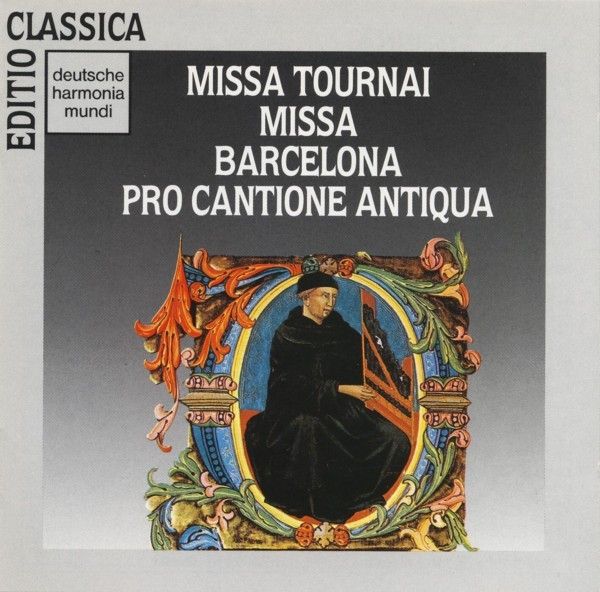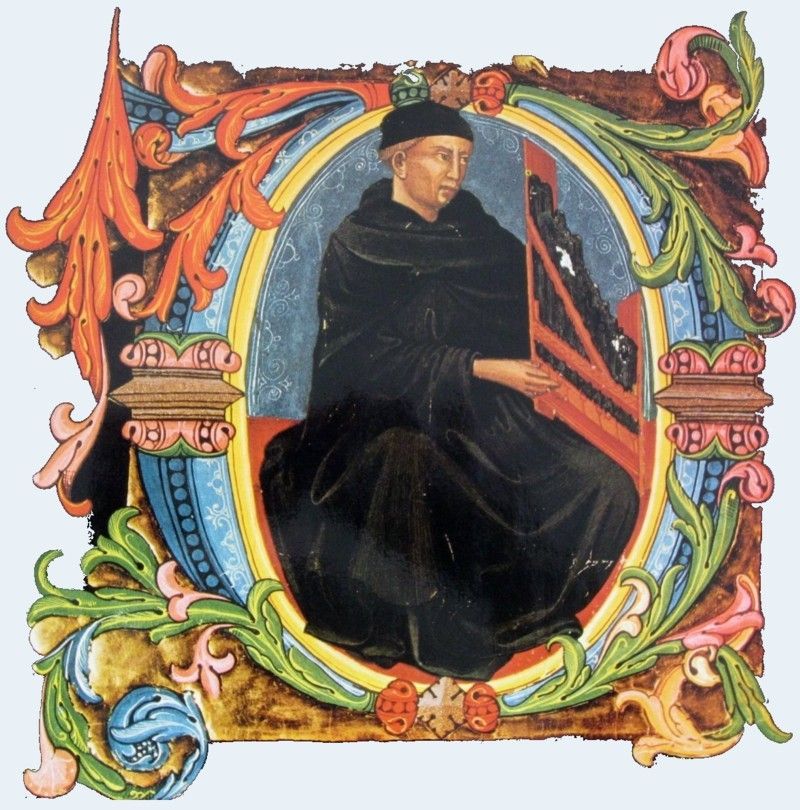Missa Tournai · Missa Barcelona
Pro Cantione Antiqua, Mark Brown

medieval.org
Deutsche Harmonia mundi (EMI) 1C 065-99 870
1980, LP
Deutsche Harmonia mundi (BMG) GD 77195
1992, CD
MISSA TOURNAI
1. Kyrie [3:03]
2. Gloria [7:32]
3. Credo [4:50]
4. Sanctus, Benedictus [3:19]
5. Agnus Dei [1:47]
6. Ite Missa est ~ Cum venerint ~ Se grasse [1:59]
MISSA BARCELONA
7. Kyrie [1:43]
8. Gloria ~ Gloriatropus [5:54]
9. Credo [6:56]
10. Sanctus ~ Sacro sanctus pater ~ Sanctus miro Gaudio [4:25]
11. Agnus Dei [2:25]
PRO MUSICA ANTIQUA, London
Mark Brown
Kevin Smith, Timothy Penrose — countertenor
Ian Partridge, James Griffett — tenor
Michael George, Richard Wistreich — bass
Alan Cuckston, positive organ

Das Orgelpositiv ist eine Kopie des Instrumentes in der Münchner
Residenz, gebaut von der Firma Sandtner. Mit freundlicher Genehmigung
von Herrn Willi Kober.
Ⓟ1980 harmonia mundi, D-7800 Freiburg
Ⓟ1992 harmonia mundi, D-7800 Freiburg
Aufnahme: Paul Dery, Monika Werner
Technik: Sonart, France
Aufgenommen: 24.-26.VI.1979, Pfarrkirche Schloß Kirchheim
Kommentar: Alfred Beaujean
Obersetzung: M. Sennet (French)
Tropen zu den Messetexten: nach der Ausgabe von Leo Schrade 1956 und
dem Originalmanuskript ins Deutsche übersetzt von Dietrich Wittke
Titelbild: Initiale aus dem Codice Squarcialupi
Mit freundlicher Genehmigung: Scala und Biblioteca Medicea Laurenziana,
Florenz
Photo Rückseite: dhm Archiv
Redaktion: Dr. Jens Markowsky
All rights reserved
HARMONIA MUNDI D-7800 FREIBURG

Musical history in the 14th century is marked by two decisive
developments: the ars nova which began with Philippe de Vitry
around 1320 and came to replace the discant and conductus styles of
composition by the isorhythmic motet; and the first polyphonic settings
of the Ordinary of the mass as a complete cycle. Although there
is no direct connection between these two developments, the stylistic
revolution had an effect upon the early musical settings of the
Ordinary.
In the 13th century polyphony was particularly used for the Proper
(those parts of the mass whose text vary from day to day); in the 14th,
on the other hand, it is the Kyrie, Gloria, Credo,
Sanctus/Benedictus and Agnus Dei — i. e. those five
sections of the sung mass which have the same text in every mass and
thus form a framework for the whole — which come into prominence.
In addition to various compositions for individual text, six settings
of the complete Ordinary have survived from the 14th century, of which
Guillaume de Machaut's famous Notre Dame mass occupies a
special place in musical history. Machaut's masterpiece is, however, in
no way typical of the period; rather it is the exception, a unified
musical cycle composed by a great musician and pointing the way into
the future. The other surviving Ordinaries were not composed in one
piece, but are rather collections of single compositions of diverse
origin; presumably, purely practical purposes were responsible for
their being compiled into complete cycles. Thus, one looks in vain for
any over-riding formal principals of construction such as may be found
in Machaut or in the later Netherland masses. Today these cycles are
called by the names of the places in which the original manuscripts are
to be found. Of the two masses recorded here, the one is in the Chapter
Library of the Cathedral in Tournai and the other is kept in the
Biblioteca Central de Cataluña in Barcelona. Parts of the cycles
are also found in other sources. The names of the composers are not
known.
The oldest of these masses is the Tournai cycle. In addition to the
five items of the Ordinary, this work includes a double motet which
combines the Ite, Missa est as tenor part with a Latin text on
brotherly love and an old French love song — a frequent practice,
which was banned by Pope John XXII in 1324. All of the pieces are in
three parts, each of which is accompanied by text and thus to be sung.
Apart from the Credo, the tenor parts of all the pieces are similar,
perhaps indicating that they all have some underlying liturgical melody
in common; nonetheless, the individual pieces are so different from one
another as to indicate that they were composed at different periods.
The quite archaic Kyrie, as well as the Sanctus/Benedictus
and the Agnus Dei — those parts with relatively little
text — were probably written in the late 13th century. The three
voices move parallel to one another in strict rhythm, resulting in a
uniform succession of chords broken a bit by small decorative passages
in one of the parts or by hocket-like shifts in rhythm. The two large
pieces and the Ite, Missa est were definitely influenced by the
ars nova and can therefore not have been composed before 1320.
Unlike the smaller pieces with their uniform movement in all parts, we
have here a relatively tranquil tenor part with two animated upper
voices; the general pattern of an isorhythmic motet with its rhythmic
schemes is evident. This is particularly true of the protracted Amen
of the Gloria and the complicated Ite, Missa est with its three
different texts. The Tournai mass was published in 1861 and is thus
among the first musical documents of the 13th/14th century which came
to be generally known.
Not until 1935 on the other hand, did the Barcelona mass become
accessible through the work of the Spanish researcher Higinio
Anglés. In comparison with the Tournai mass, it seems that the
compiler was interested here in collecting particularly impressive
pieces. Once again, the five pieces show no unity of style or general
conception; neither in the number of voices nor in the compositional
technique do they have any common ground. Typically for the period the
first four movements are in three-part harmony; the Agnus Dei
has four parts. The various movements differ likewise in their
structure, which in places leads to technical complications which could
be dealt with only by an excellently trained choir. The compilation was
thus evidently intended for use in an important cathedral; on this,
however, no more specific information is available.
The Kyrie consists of three vocal parts accompanied by text and
rigidly coupled to one another, much as in the Tournai Kyrie. By
contrast, it is possible that the Gloria and Credo
might have been performed using a mixture of voice and instruments, for
these pieces bear a similarity to so-called discant compositions in
which one somewhat more animated vocal part is accompanied by two more
tranquil voices. In the Gloria every second verse is troped,
i.e. interspersed with sacred, although not liturgical texts.
Complicated compositional devices are most prominent in the Sanctus
and the Agnus Dei. Like the Ite, Missa est of the
Tournai mass, the Sanctus is written in the form of an
isorhythmic motet; the two upper voices are once again accompanied by
Latin tropes, so that the liturgical text can scarcely be heard. In the
Agnus Dei the highest and lowest voices are without text,
although one of them could easily be given a text, resulting in three
sung voices with an instrumental fourth accompanying. In our recording,
however, all of the parts are sung; those with no text are vocalised.
The organ has a merely supportive function, making no independent
contribution to the music.




